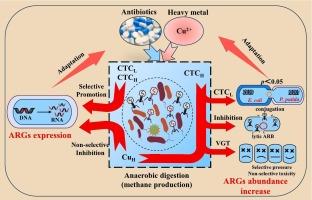抗生素耐药基因表达及病毒群落对抗生素和重金属厌氧消化的介导作用
IF 13.2
1区 工程技术
Q1 ENGINEERING, CHEMICAL
引用次数: 0
摘要
本研究探讨了氯四环素(CTC)和铜(Cu)单独和联合使用对厌氧消化(AD)中抗生素耐药基因(ARGs)转移和表达的影响。利用宏基因组学和高通量定量PCR (HT-qPCR),我们发现高浓度Cu(400 mg/L)和CTC(80 mg/L)显著增加了ARGs的相对丰度,这是由于细菌群落的变化(p <; 0.05),而较低浓度(Cu: 40 mg/L;CTC: 8 mg/L)影响最小。物种丰度分布和中性模型表明,抗生素抗性组是由随机过程决定的,而ARGs丰度是由有限数量的核心ARGs决定的,显示出对抗生素和重金属选择的弹性。逆转录HT-qPCR结果显示,大多数ARGs沉默或低水平表达;然而,无论浓度如何,CTC都增强了ARGs的表达,特别是与四环素核糖体保护相关的ARGs的表达。相比之下,由于其非选择性毒性,高Cu水平抑制了ARGs的表达,这可以通过不能产生甲烷来证明。CTC和Cu对宏基因组学显示的ARGs潜在迁移率的影响都有限,尽管TET显著增加了偶联试验反映的偶联频率(p <; 0.05)。病毒携带的ARGs仅占总数的0.26 %±0.10 %,没有噬菌体介导转导的证据,噬菌体裂解显著有助于ARGs的减少。虽然CTC和Cu对携带噬菌体的ARGs的影响有限,但通过病毒-宿主比和噬菌体裂解实验表明,它们明显抑制了噬菌体裂解活性,进一步导致ARGs在AD系统中的富集。我们的研究结果为AD患者在抗生素和重金属选择性压力下ARGs的转移提供了新的见解。本文章由计算机程序翻译,如有差异,请以英文原文为准。

Response of antibiotic resistance genes expression and mediating role of viral community to antibiotics and heavy metals in anaerobic digestion
This study investigated the effects of chlortetracycline (CTC) and copper (Cu), individually and in combination, on the transfer and expression of antibiotic resistance genes (ARGs) in anaerobic digestion (AD). Utilizing metagenomics and high-throughput quantitative PCR (HT-qPCR), we found that high concentrations of Cu (400 mg/L) and CTC (80 mg/L) significantly enriched the relative abundance of ARGs attributed to the changes of bacterial community (p < 0.05), whereas lower concentrations (Cu: 40 mg/L; CTC: 8 mg/L) had minimal effects. The species abundance distribution and neutral models indicated that antibiotic resistome is determined by stochastic process, and the abundance of ARGs is determined by a limited number of core ARGs, showing the resilient to the selection of antibiotics and heavy metals. Reverse transcription HT-qPCR indicated that most ARGs were silent or expressed at low levels; however, regardless of the concentration, CTC enhanced the expression of ARGs, particularly those linked to tetracycline ribosome protection. In contrast, high Cu levels inhibited ARGs expression due to its non-selective toxicity, which was evidenced by a failure to produce methane. CTC and Cu both showed limited impacts on the potential mobility of ARGs shown by metagenomics, although TET significantly increased the conjugation frequency reflected by conjugation assays (p < 0.05). ARGs carried by virus only accounted for 0.26 % ± 0.10 % of the total, with no evidence of phage-mediated transduction, and phage lysis significantly contributed to ARGs reduction. While CTC and Cu showed limited effects on phage-carrying ARGs, they notably inhibited phage lytic activity, as indicated by virus-host ratios and phage lysis tests, further leading to the enrichment of ARGs in AD system. Our findings provide novel insights into the ARGs transfer under selective pressure of antibiotics and heavy metals in AD.
求助全文
通过发布文献求助,成功后即可免费获取论文全文。
去求助
来源期刊

Chemical Engineering Journal
工程技术-工程:化工
CiteScore
21.70
自引率
9.30%
发文量
6781
审稿时长
2.4 months
期刊介绍:
The Chemical Engineering Journal is an international research journal that invites contributions of original and novel fundamental research. It aims to provide an international platform for presenting original fundamental research, interpretative reviews, and discussions on new developments in chemical engineering. The journal welcomes papers that describe novel theory and its practical application, as well as those that demonstrate the transfer of techniques from other disciplines. It also welcomes reports on carefully conducted experimental work that is soundly interpreted. The main focus of the journal is on original and rigorous research results that have broad significance. The Catalysis section within the Chemical Engineering Journal focuses specifically on Experimental and Theoretical studies in the fields of heterogeneous catalysis, molecular catalysis, and biocatalysis. These studies have industrial impact on various sectors such as chemicals, energy, materials, foods, healthcare, and environmental protection.
 求助内容:
求助内容: 应助结果提醒方式:
应助结果提醒方式:


